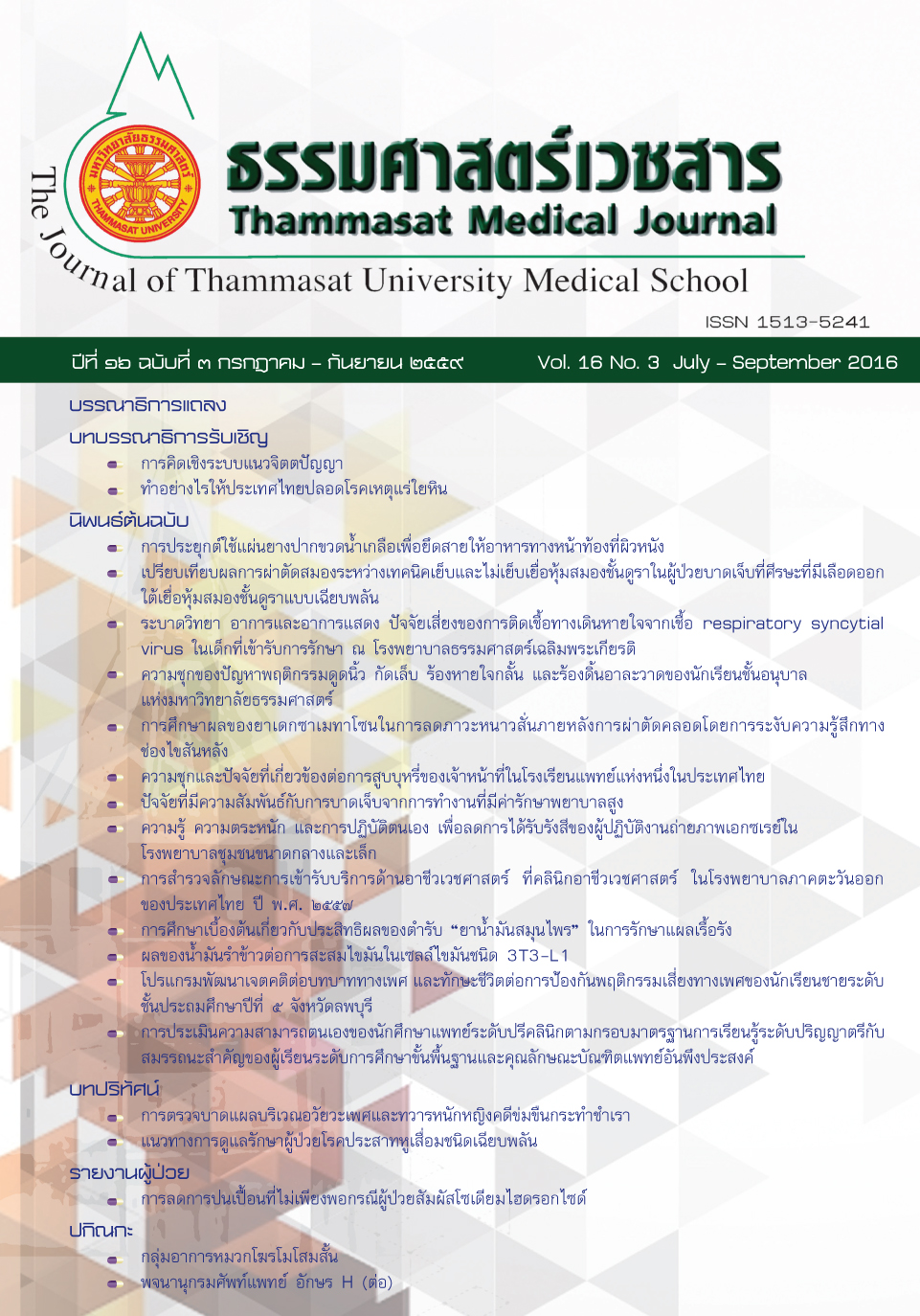Epidemiology, clinical manifestation and risk factors of respiratory syncytial virus infection in children at Thammasat University Hospital
คำสำคัญ:
Respiratory syncytial virus (RSV), Pneumonia, Bronchiolitis, Upper respiratory tract infection (URI), Severe RSV infection, Children, RSV, โรคปอดอักเสบ, โรคหลอดลมฝอยอักเสบ, การติดเชื้อทางเดินหายใจส่วนบน, โรคติดเชื้อ RVS รุนแรง, เด็กบทคัดย่อ
Introduction: Respiratory syncytial virus (RSV) is the leading cause of respiratory illness in young children and often results in severe disease and hospitalization, particularly in children aged < 5 years. The purpose of this study was to review the epidemiology, clinical manifestation and risk factors of RSV infection in children.
Method: The descriptive study enrolled children under 5 years of age who were visited the Thammasat University Hospital between October, 2011 and September, 2013 due to acute respiratory tract infection from RSV. RSV was detected by rapid immunochromatography assay from nasal swab. Severe RSV infection included pneumonia and bronchiolitis.
Result: A total of 300 children were studied. 183 cases (61.0%) were at the age of 2 months to 2 years. Thirty patients (10.0%) were born prematurely. 57 cases (19.0%) had underlying medical condition. The most common underlying condition was pulmonary disease included 18 asthma and 9 chronic lung disease. 261 (87.0%) cases were raised in home. Most common symptoms are coughing (95.7%) and runny nose (80.0%). The proportion of RSV infection was highest between July and October (9.3 - 40.7%). The most common clinical diagnosis was pneumonia (74.0%), followed by upper respiratory tract infection (URI) (14.9%), bronchiolitis (7.2%) and bronchitis (3.9%). The percentage of severe RSV infection decreased with age; from under 2 months, 95.2%; from 2 months to 2 years, 81.4% and from over 2 years; 50.0%. The aged under 2 months had 4 fold increased risk for severe RSV infection (pneumonia and bronchiolitis) (odds ratio 4.09, [95% confidence interval 1.21 - 13.77]) Three patients required mechanical ventilation and all cases had existing co-morbidity (2 had chronic lung disease and 1 had neuromuscular disease).
Discussion and Conclusion: The cases of RSV infection were highest during July to October especially in children aged 2 months to 2 years. Majority of RSV infected cases were no underlying medical condition. The most clinical diagnosed was pneumonia. The risk factor associated with severe RSV infection was the age under 2 months.
บทนำ: เชื้อ respiratory syncytial virus (RSV) เป็นสาเหตุของการติดเชื้อทางเดินหายใจในเด็ก มักก่อให้เกิดอาการรุนแรงต้องรับการรักษาในโรงพยาบาลโดยเฉพาะในเด็กอายุน้อยกว่า ๕ ปี การศึกษานี้มีวัตถุประสงค์เพื่อทราบระบาดวิทยา อาการ อาการแสดง และปัจจัยเสี่ยงต่อการติดเชื้อ RSV ในผู้ป่วยเด็ก
วิธีการศึกษา: เป็นการศึกษาวิจัยย้อนหลังเชิงพรรณนาในเด็กอายุน้อยกว่า ๕ ปี ที่เข้ารับการรักษา ณ โรงพยาบาลธรรมศาสตร์เฉลิมพระเกียรติ ระหว่างเดือนตุลาคม พ.ศ. ๒๕๕๔ ถึงเดือนกันยายน พ.ศ. ๒๕๕๖ ที่มีอาการทางเดินหายใจจากเชื้อ RSV ซึ่งตรวจพบเชื้อจากโพรงจมูกด้วยวิธี rapid immunochromatography assay โดยโรคติดเชื้อ RSV ที่รุนแรงคือ โรคปอดอักเสบและโรคหลอดลมฝอยอักเสบ
ผลการศึกษา: เด็กจำนวน ๓๐๐ คน มีอายุระหว่าง ๒ เดือนถึง ๒ ปีจำนวน ๑๘๓ คน (ร้อยละ ๖๑.๐) มีประวัติคลอดก่อนกำหนดจำนวน ๓๐ คน (ร้อยละ ๑๐.๐) มีโรคประจำตัว ๕๗ คน (ร้อยละ ๑๙.๐) เป็นโรคปอดมากที่สุดคือ โรคหอบหืด ๑๘ คนและโรคปอดเรื้อรัง ๙ คน ส่วนใหญ่เลี้ยงดูที่บ้าน ๒๖๑ คน (ร้อยละ ๘๗.๐) อาการที่พบมากที่สุดคือ ไอ (ร้อยละ ๙๕.๗) และน้ำมูกใส (ร้อยละ ๘๐.๐) พบการติดเชื้อ RSV มากที่สุดในช่วงเดือนกรกฎาคมถึงตุลาคม (ร้อยละ ๙.๓ ถึง ๔๐.๗) ได้รับการวินิจฉัยเป็นโรคปอดอักเสบมากที่สุด (ร้อยละ ๗๔.๐) รองลงมาคือการติดเชื้อทางเดินหายใจส่วนบน (ร้อยละ ๑๔.๙) โรคหลอดลมฝอยอักเสบ (ร้อยละ ๗.๒) และโรคหลอดลมอักเสบ (ร้อยละ ๓.๙) โดยโรคติดเชื้อ RSV ที่รุนแรงจะพบลดลงในเด็กที่อายุมากขึ้นคือ อายุน้อยกว่า ๒ เดือนพบร้อยละ ๙๕.๒ อายุ ๒ เดือนถึง ๒ ปีพบร้อยละ ๘๑.๔ และอายุมากกว่า ๒ ปีพบร้อยละ ๕๐.๐ เด็กที่อายุน้อยกว่า ๒ เดือนมีความเสี่ยงเพิ่มขึ้น ๔ เท่าต่อโรคติดเชื้อ RSV ที่รุนแรง (odd ratio ๔.๐๙, [95% confidence interval ๑.๒๑ - ๑๓.๗๗]) พบผู้ป่วย ๓ คนที่ต้องใช้เครื่องช่วยหายใจโดยทุกคนมีโรคประจำตัว (โรคปอดเรื้อรัง ๒ คนและโรคทางระบบประสาท ๑ คน)
วิจารณ์ และสรุปผลการศึกษา: โรคติดเชื้อทางเดินหายใจจากเชื้อ RSV พบมากในช่วงเดือนกรกฎาคมถึงตุลาคม โดยเฉพาะในเด็กอายุระหว่าง ๒ เดือนถึง ๒ ปี ผู้ป่วยส่วนใหญ่ไม่มีโรคประจำตัว เชื้อ RSV ก่อให้เกิดโรคปอดอักเสบมากที่สุด ปัจจัยเสี่ยงที่สัมพันธ์กับการติดเชื้อ RSV ที่รุนแรงคือ อายุน้อยกว่า ๒ เดือน



